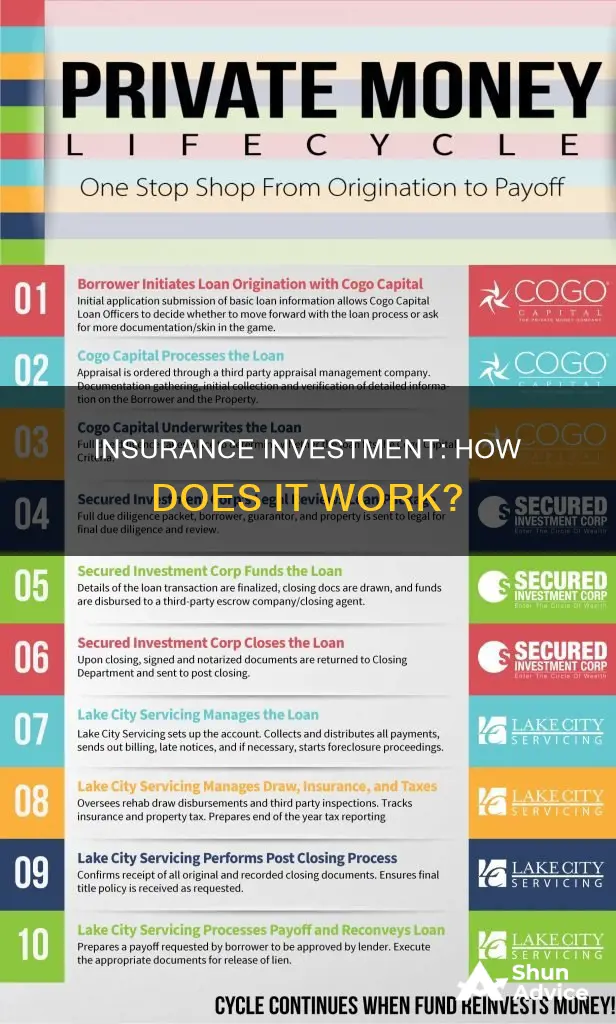
Life insurance is a financial product that provides financial protection for your loved ones in the event of your death. It can also be used as an investment vehicle, with some policies offering cash value accounts that can accumulate wealth over time. Term life insurance is a basic form of protection that offers a tax-free lump sum to beneficiaries upon the insured's death, while permanent life insurance offers additional benefits such as investment savings components. Investment-linked insurance policies (ILPs) combine life insurance coverage with investments, allowing policyholders to invest in sub-funds while maintaining insurance protection. However, it's important to consider the costs, risks, and potential low returns associated with using life insurance as an investment.
How Does Insurance Investment Work?
| Characteristics | Values |
|---|---|
| Insurance Type | Term Life Insurance, Whole Life Insurance, Universal Life Insurance, Investment-Linked Insurance Policies (ILPs) |
| Investment Component | Term life insurance does not have an investment component. Whole life insurance, universal life insurance, and ILPs have an investment savings component. |
| Cash Value | Term life insurance does not have a cash value account. Whole life insurance and universal life insurance have a cash value that can be treated as an investment. |
| Premiums | In term life insurance, premiums go towards securing a death benefit for beneficiaries. In ILPs, premiums are used to purchase units in sub-funds, with some units sold to pay for insurance and charges, and the rest remaining invested. |
| Flexibility | ILPs offer flexibility to change investments by switching sub-funds and varying insurance coverage as financial needs change. |
| Risk | ILPs do not have guaranteed returns, and the policyholder bears the full investment risk. The value of units depends on the sub-fund's performance. |
| Charges | Insurance charges in ILPs are paid for by the investment portion, and these charges increase with age. |
| Peace of Mind | Term life insurance offers peace of mind by providing basic protection in the form of a death benefit for beneficiaries at an affordable price. |
| Investment Returns | In ILPs, investment returns are based on the sub-fund's performance, so it is important to select a sub-fund that aligns with your investment objectives and risk profile. |
| Tax Advantages | Life insurance can provide tax advantages, such as tax-free lump-sum death benefits and tax-efficient monthly income in retirement. |
| Investment Strategies | Insurance companies invest in various areas, including bonds, stocks, mortgages, and liquid short-term investments. |
What You'll Learn

Permanent life insurance with an investment savings component
Permanent life insurance is a type of insurance policy that covers you for life as long as your premiums are paid. Certain types of permanent life insurance also have an investment or savings component that allows policyholders to accumulate a cash value. This is known as whole life insurance.
Whole life insurance combines life insurance with an investment component. When you pay your premium, the insurer invests a portion to give your policy a cash value. The cash value grows over time at a fixed rate guaranteed by your insurer. It’s tax-deferred, which means that any interest you earn isn’t taxed as long as you keep the funds in the policy. Once you’ve accumulated enough cash value, you can begin to take out loans against your policy. While you don't need to pay back these loans, your insurer will subtract any outstanding amount from the payout when you die.
Universal life insurance is another type of permanent life insurance with an investment savings component. Unlike whole life insurance, the cash value in universal life insurance grows at a variable rate, meaning returns are subject to market conditions and aren't guaranteed.
Investment-linked insurance policies (ILPs) are another type of insurance policy that combines life insurance coverage and investment. Your premiums are used to pay for units in one or more sub-funds of your choice. Some of the units purchased are then sold to pay for insurance and other charges, while the rest remain invested. The value of these units depends on their price, which in turn depends on the sub-fund’s performance. This is why ILPs usually do not have any guaranteed cash values.
It's important to remember that life insurance and investing serve two different purposes. Buying a cash-value life insurance policy should not be your primary wealth-building or retirement strategy. Life insurance is meant to protect your loved ones financially, not to replace smart investing for your future.
Retirement Planning: Your Investment Mix
You may want to see also

Term life insurance as an investment
Term life insurance is a guaranteed life benefit paid to the insured's beneficiaries after death. The policies last for a specified term, usually 10, 15, 20 years or more. Unlike permanent life insurance, term life insurance doesn't have any cash value and therefore doesn't have an investment component. When you buy a term policy, all of your premiums go toward securing a death benefit for your beneficiaries. If you're still alive when the term ends, the policy simply lapses and you and your beneficiaries don't receive any money.
However, you can think of term life insurance as an investment in the sense that you are paying relatively little in premiums in exchange for the peace of mind of knowing that if you die, your beneficiaries will receive a relatively large death benefit. This strategy refers to buying a term life policy and investing the additional money you would have spent on a permanent policy in something else, such as stocks.
If you decide you want to extend your term life policy indefinitely, your insurer may allow you to convert it to permanent life insurance coverage. Doing so may increase your premiums but it may be a worthwhile investment if you want to have coverage for life. Converting could also give you the opportunity to accumulate cash value.
There are two main types of permanent life insurance that can be used as an asset: whole life insurance and universal life insurance. Depending on your life insurance plan, you may be able to take a loan from your policy, use it as collateral for a loan, withdraw funds, receive “accelerated benefits” or cash out the policy.
Investment Firm Etiquette: Dinner and a Deal?
You may want to see also

Investment-linked insurance policies (ILPs)
When you pay premiums for an ILP, this money is used to purchase units in one or more sub-funds of your choice. Some of these units are then sold to cover insurance charges and other fees, while the remaining units continue to be invested. The value of these units depends on their price, which is determined by the performance of the sub-fund. Therefore, investment returns are based on the sub-fund's performance, and there are no guaranteed returns. You bear the full investment risk.
ILPs can provide insurance protection in the event of death or, if included in the policy, total and permanent disability (TPD). The benefit paid out will depend on the policy and may be the sum assured, the value of the units in the sub-fund at that time, or a combination of the two.
ILPs are generally better suited to those with a longer investment horizon, as this helps to ride out market fluctuations and defray initial costs, which can significantly limit short-term potential returns. It is important to note that ILPs usually do not have any guaranteed cash values, so there is a risk of losing the entire value of your investment.
Before purchasing an ILP, it is essential to understand the investment strategy and potential risks associated with the sub-funds offered by the insurer. You should also be aware that the cost of insurance typically increases year on year as the risk of death, disability, and illness increases.
Berkshire Hathaway's Dividend Play: Unlocking the Secrets of Their Investment Strategy
You may want to see also

Insurance companies investing in the stock market
Insurance companies have highly attractive economics. They are given money by customers, which they hold until a claim needs to be paid. In the meantime, they can invest this money for their own benefit. This is why insurance companies are often a favourite for dividend investors. They are also a popular choice for investors because they are recession-resistant. During tough economic times, people still need to maintain auto and homeowners coverage, for example. Therefore, insurance is a business that can produce excellent long-term returns without too much volatility.
Insurance companies make money by charging premiums to the insured and investing the insurance premium payments. They sell policies that promise to pay out a benefit to the policyholder if a covered event occurs during the term of the policy. For example, with life insurance, the covered event would be the death of the insured. With homeowners insurance, it might be a house fire, storm damage or theft. In exchange for the insurance coverage, the policyholder pays the insurer premiums, which are invested to earn a profit for the company until they are needed to pay out claims.
Historically, insurance companies were structured as mutual companies, owned by the policyholders and operated only for the benefit of policyholders. On the other hand, stock companies are owned by shareholders and they seek to maximize returns to shareholders. In recent years, many mutual companies have converted into stock companies in a process called demutualization. Because mutual companies do not issue shares to the public, only stock companies can be invested in the stock market.
When evaluating life insurance companies, it is important to know that government regulation directs them to maintain an asset valuation reserve (AVR) as a cushion against substantial losses of portfolio value or investment income. Therefore, these companies tend to have less financial leverage at work than other kinds of financial institutions. This poses potential valuation problems since it implies that insurers value assets at market value but liabilities at book value.
Some prominent insurance companies that are worth considering for investment include MetLife, Markel, UnitedHealth, PRU, and AIG.
Mutual of America: Worth the Investment?
You may want to see also

Life insurance as an investment in retirement planning
Life insurance is often considered a crucial component of retirement planning. It can provide financial security and peace of mind during an individual's golden years. Permanent life insurance, which includes variable, universal, and whole life policies, is sometimes promoted as a retirement savings vehicle. These policies offer tax-deferred growth potential and the ability to borrow money tax-free, making them attractive to those seeking tax advantages. However, it's important to weigh the costs and benefits of these policies compared to other retirement options.
One advantage of permanent life insurance is the opportunity to build cash value over time. This means that the policy accumulates a cash amount that can be accessed during retirement. If you purchase a permanent policy when you're young, the cash value may grow significantly by the time you retire. This can be beneficial if you need funds to cover various retirement expenses. However, withdrawing cash from the policy may reduce the death benefit, so it's important to consider your priorities.
Term life insurance, on the other hand, is a more affordable option that provides coverage for a specified term, typically 10, 15, or 20 years. While it doesn't have the same investment component as permanent life insurance, it can still be considered an investment in the sense that it offers peace of mind and financial protection for your beneficiaries in the event of your death. Additionally, term life insurance allows you to use the savings in your policy to invest in other retirement accounts, such as a health savings account or a Roth IRA.
Investment-linked insurance policies (ILPs) are another option that combines life insurance coverage with an investment component. ILPs offer flexibility, allowing you to switch between sub-funds to align with your financial goals and risk tolerance. However, it's important to note that ILPs do not guarantee returns, and you bear the full investment risk. The value of your investment depends on the performance of the chosen sub-funds.
When considering life insurance as an investment in retirement planning, it's essential to assess your individual needs and goals. Permanent life insurance policies can be costly, and the returns may not always be sufficient to fully fund your retirement. Therefore, it's recommended to consult with a financial advisor to determine the best course of action for your specific situation. They can help you navigate the complexities of different insurance products and retirement strategies to ensure you make informed decisions.
Lucrative Investment Opportunities: Exploring Avenues with 10 Percent Returns
You may want to see also
Frequently asked questions
Term life insurance is a guaranteed life benefit paid to the insured's beneficiaries after death. Policies last for a specified term, usually 10, 15, 20 years or more. Permanent life insurance, on the other hand, is indefinite and may have a savings component.
Term life insurance is a great way to ensure your loved ones will have the funds needed to replace your income in your absence. It is also affordable and doesn’t have many tax restrictions or regulations.
Insurance companies invest in many areas, including bonds, stocks, mortgages and liquid short-term investments. Insurance companies tend to invest the most money in bonds as they are the safest of all investment categories.







